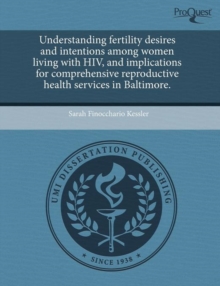Since highly active antiretroviral therapy (HAART) was introduced in 1995, continual advances in treatment and prevention have changed both the short and long term expectations of many people living with HIV/AIDS about the potential to deliver an uninfected child.
With the risk of Mother-to-Child HIV Transmission (MTCT) as low as 1%-2%, significant barriers to childbearing among women living with HIV/AIDS in the U.S have been minimized.
In light of these advances, more HIV-infected women and their partners are deciding to have children (Sharma et al., 2007, Riley & Yawetz, 2005), increasing the need for reproductive counseling to plan safe conception and pregnancy.
This dissertation responds to three primary questions: (1) What are the predictors of fertility desires and intentions among HIV-infected women of reproductive age?, (2) To what extent are women discussing reproductive plans with HIV providers?, and (3) Do childbearing motivations, pregnancy desires and consistent condom use differ significantly between HIV-infected and HIV-uninfected adolescents age 15-24 years?
Chapters 1-4 describe childbearing among HIV-infected women in the U.S., illustrate theoretical influences of fertility intentions, characterize social and contextual factors in Baltimore that increase vulnerability, and describe the study design and methods employed.
Paper 1 describes the predictors of fertility intentions among HIV-infected women.
Fertility desires (59%) and fertility intentions (66% of those who desire a child) are high among the women interviewed, and accurate knowledge of MTCT is low (only 15%).
In multivariate analysis high positive childbearing motivations, desire to have a child, perceived partner desire for a child, and accurate knowledge of MTCT are all significantly and positively associated with the intention to have a child, while having an AIDS diagnosis is negatively associated with the intention to have a child (p<0.05).
Women who desire a child and perceive a positive response from their partner to becoming pregnant are nearly 7 times more likely to intend to have a child compared with women who desire a child, but do not think their partner shares their desire (AOR 6.7, 95%CI 2.2-20, p=0.001).
Paper 2 summarizes women's communication with their HIV provider about pregnancy.
General discussions about HIV and pregnancy occurred with 67% of women sampled, but personalized discussions about future fertility plans were reported by only 31% of the total sample; the majority of whom said they initiated the conversation.
The absence of personalized communication among women who have pregnancy desires and want to discuss them with their HIV provider (n=40, 56%) is particularly troubling.
Predictors of communication about pregnancy with HIV providers are younger age (<30 years), and the desire to discuss pregnancy (p<0.05).
In paper 3, we found that among adolescents (15-24 years), positive childbearing motivations, and both immediate and future pregnancy desires did not differ significantly according to HIV serostatus.
The desire for future childbearing is high (HIV-uninfected=85%, HIV-infected=83%, p=0.67).
Those with future pregnancy desires were 52% less likely to use condoms consistently than were those who do not want a child in the future (AOR 0.48, p=0.035).
Consistent condom use is low in both groups, but HIV-infected adolescents are more likely to report always using condoms with their primary partner compared to HIV-uninfected adolescents (X2=3.98, p=0.046, AOR 2.43, p=0.057).
Many HIV-infected women want and intend to pursue childbearing.
These motivations and desires do not appear to differ significantly from...

